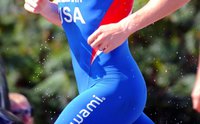A Few Facts on Fat and Power to Weight Ratio
Posted by Matt Russ on 16th Jul 2015
Fat is the athletes enemy correct? If you are trying to achieve a mo re effective power
to weight ratio body fat is the ballast you want to drop, contradictory, during
endurance training and events fat is the fuel source you want to utilize the
most. Endurance sport efficiency is largely dependant upon access and
utilization of fat as a fuel source. Working at an intensity that results in
the highest fat oxidation (Fatmax) is the key to success in long endurance
events.
re effective power
to weight ratio body fat is the ballast you want to drop, contradictory, during
endurance training and events fat is the fuel source you want to utilize the
most. Endurance sport efficiency is largely dependant upon access and
utilization of fat as a fuel source. Working at an intensity that results in
the highest fat oxidation (Fatmax) is the key to success in long endurance
events.
Training or racing at intensities above Fatmax are costly in terms of carbohydrate usage. Not only does fat utilization decrease but carbohydrate calorie contribution increases dramatically. Typical Fatmax is 35-40 grams per hour.
Carbohydrate has less than half the energy per gram as fat. This means you must burn twice the carbohydrate calories to equal the cost of one gram of fat.
When carbohydrate stores are depleted in the body the amount of energy you can produce is significantly reduced, and the body turns to stored fat as it's primary fuel source. And a typical athlete will have enough energy stored in body fat to perform several marathons back to back.
Even though you may burn hundreds of calories of carbohydrate per hour, you may only consume a limited amount, usually 60-80g per hour or 240-320 calories. And the harder you are working the harder it will be to take consume calories. Gastric emptying increases at intensity and blood (and oxygen) are shunted away from the digestive system to working muscles.
Fast twitch muscle fibers utilize more carbohydrate than slow twitch fibers. Sustained high intensities, jumps, sprints, and otherwise full exertions more quickly deplete glycogen stores.
So, that extra spare tire you are carrying is actually good then? Sorry, body fat is not metabolically active, does not directly contribute to speed, may hinder cooling, increases aerodynamic drag, and indirectly increases your VO2 max (if you were to compare yourself at a lower body fat percentage). Even if your body fat is as low as 5%, you have plenty of stored energy for your next event.
Being aerobically (fat burning) efficient and readily utilizing fat stores for events over two hours is critically important. Events using predominantly your aerobic energy system are as much about conserving energy as utilizing it. Utilizing fat optimally will depend on you knowing your sources of energy, at what intensity they are accessed at, and how to pace yourself appropriately.
When is the best time to loose body fat? In order to decrease body fat you have to create a caloric deficit. However, this can have a direct and negative impact on your training and racing. The best time to loose body fat is when it has the least negative affect on your training. For most of us that will be the winter months or base season when intensity is lower and racing is infrequent. Unfortunately, this is the most common time to gain weight. For best results loose the body fat when it has the least implication on your training and remember; a slow steady weight loss is far preferable to a quick loss.
References
Peak Performance Cycling; number 224: 1-4
Matt Russ has coached and trained elite athletes from around the country and internationally for over ten years. He currently holds Elite licenses from USA Triathlon, USA Cycling, and is a licensed USA Track and Field Coach. Matt is head coach and owner of The Sport Factory, and works with athletes of all levels full time. He is a free lance author and his articles are regularly featured in a variety of magazines. Visit www.sportfactory.com for more information or email him at coachmatt@thesportfactory.com


